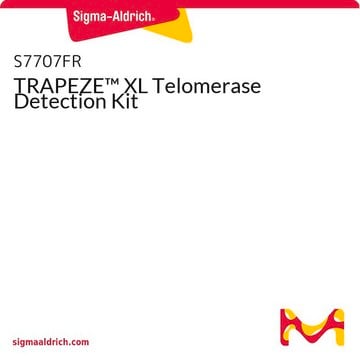S7700-M
TRAPeze™ Telomerase Detection Kit
Se connecterpour consulter vos tarifs contractuels et ceux de votre entreprise/organisme
About This Item
Code UNSPSC :
12161503
eCl@ss :
32161000
Nomenclature NACRES :
NA.84
Produits recommandés
Description générale
Telomeres are specific structures found at the ends of chromosomes in
eukaryotes. In human chromosomes, telomeres consist of thousands of copies of 6 base repeats (TTAGGG). It has been suggested that telomeres protect chromosome ends, because damaged chromosomes lacking telomeres undergo fusion, rearrangement and translocation. In somatic cells, telomere length is progressively shortened with each cell division both in vivo and in vitro, due to the inability of the DNA polymerase complex to replicate the very 5′ endof the lagging strand .
Telomerase is a ribonucleoprotein that synthesizes and directs the telomeric
repeats onto the 3′ end of existing telomeres using its RNA component as a
template. Telomerase activity has been shown to be specifically expressed in immortal cells, cancer and germ cells, where it compensates for telomere shortening during DNA replication and thus stabilizes telomere length. These observations have led to a hypothesis that telomere length may function as a “mitotic clock” to sense cell aging and eventually signal replicative senescence or programmed cell death. Therefore, expression of telomerase activity in cancer cells may be a necessary and essential step for tumor development and progression. The causal relationship between expression of telomerase and telomere length stabilization and the extension of the life span of the human cell has recently been reported.
eukaryotes. In human chromosomes, telomeres consist of thousands of copies of 6 base repeats (TTAGGG). It has been suggested that telomeres protect chromosome ends, because damaged chromosomes lacking telomeres undergo fusion, rearrangement and translocation. In somatic cells, telomere length is progressively shortened with each cell division both in vivo and in vitro, due to the inability of the DNA polymerase complex to replicate the very 5′ endof the lagging strand .
Telomerase is a ribonucleoprotein that synthesizes and directs the telomeric
repeats onto the 3′ end of existing telomeres using its RNA component as a
template. Telomerase activity has been shown to be specifically expressed in immortal cells, cancer and germ cells, where it compensates for telomere shortening during DNA replication and thus stabilizes telomere length. These observations have led to a hypothesis that telomere length may function as a “mitotic clock” to sense cell aging and eventually signal replicative senescence or programmed cell death. Therefore, expression of telomerase activity in cancer cells may be a necessary and essential step for tumor development and progression. The causal relationship between expression of telomerase and telomere length stabilization and the extension of the life span of the human cell has recently been reported.
The TRAPeze Telomerase Detection Kit is a highly sensitive in vitro assay system for detecting telomerase activity. The assay is a one-buffer, two-enzyme, system utilizing PCR to enhance the sensitivity of telomerase detection in small samples.
Recommended Taq polymerases: must be non-proofreading, having no exonuclease activity and capable of "hot-start." Titanium Taq, Platinum Taq are suggested.
Recommended Taq polymerases: must be non-proofreading, having no exonuclease activity and capable of "hot-start." Titanium Taq, Platinum Taq are suggested.
Informations légales
TRAPEZE is a trademark of Merck KGaA, Darmstadt, Germany
Clause de non-responsabilité
Unless otherwise stated in our catalog or other company documentation accompanying the product(s), our products are intended for research use only and are not to be used for any other purpose, which includes but is not limited to, unauthorized commercial uses, in vitro diagnostic uses, ex vivo or in vivo therapeutic uses or any type of consumption or application to humans or animals.
Code de la classe de stockage
10 - Combustible liquids
Certificats d'analyse (COA)
Recherchez un Certificats d'analyse (COA) en saisissant le numéro de lot du produit. Les numéros de lot figurent sur l'étiquette du produit après les mots "Lot" ou "Batch".
Déjà en possession de ce produit ?
Retrouvez la documentation relative aux produits que vous avez récemment achetés dans la Bibliothèque de documents.
Notre équipe de scientifiques dispose d'une expérience dans tous les secteurs de la recherche, notamment en sciences de la vie, science des matériaux, synthèse chimique, chromatographie, analyse et dans de nombreux autres domaines..
Contacter notre Service technique






